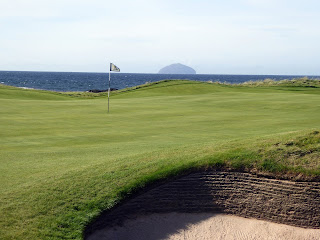
White tees par 71, SSS 72, 6511 yards
Red tees par 74, SSS 75, 5406 yards
What a difference a day makes! Compared to yesterday, this is the cream of the crop, a magnificent true links course which was the setting for the famous 'Duel in the Sun' between Tom Watson and Jack Nicklaus at the 1977 Open Championship. Turnberry lies on the Ayrshire coast on the west coast of Scotland south of a string of links courses such as Royal Troon and Prestwick.
The Ailsa course is named after the Marquess of Ailsa who commissioned Willie Fernie, the then professional at nearby Royal Troon, to design a course in 1902. The course was then taken over by the Royal Airforce in World War 2 when three concrete airstrips were constructed over the course, flattening many of the natural features. One can still be seen today. After the end of the war, Philip Mackenzie Ross, a Scottish golf architect, restored many of the dunes and slopes. The new course hosted the first of four Open Championships in 1977. It has recently been acquired by Donald Trump and a redesign of the course carried out by Mackenzie Ebert golf architects.
 |
| The walk from the 5th to the 6th tee |
 |
| The 7th green with the Ailsa Craig in the background |
The par three 4th is a testing hole with a huge bunker to carry to reach the green. The 5th is a cleverly bunkered par 5 which curves from right to left with a green set in an amphitheatre in the sand dunes. The short climb over the dunes to the 6th tee reveals a breathtaking view of Turnberry beach with the scattered islands out to sea. The golfer could be excused for being distracted at this stage but the par 3 6th needs your full attention with its front to back sloping green with trouble lurking for the short shot - hence its name 'Tappie Toorie' or 'Hit to the top'. This is followed by the par 5 7th again with lovely views from the green. The 9th is a stunning hole over a rocky inlet towards the iconic
 |
| The green at the par 3 9th is overlooked by the iconic lighthouse |
The 10th and 11th still follow the coast. The high tees at the 10th allow a view of the whole hole which is another right to left par 5 with the 'doughnut' bunker awaiting a misjudged attempt to reach the infinity green in two. This is followed by another par 3 which requires a long carry over rocky outcrops. Trouble lies short and left with thick rough through the green. The 14th has been extended to finish at the top of the hill to make the most of the views. With a double dogleg it climbs up to an
 |
| The hotel overlooks the 18th green |
Worth playing? Yes. This is a spectacular course and one of our top choices.


















